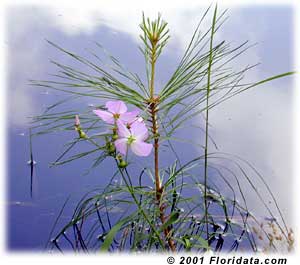
It been a hot and hectic month here in Tallahassee however rainy weather has helped us escape the record heat waves sizzling other parts of the country. Our high temperatures have held in the low 90s which is about average for us this time of year. These relatively mild conditions track the apparent return, after an absence of many years, of the daily pattern of afternoon thunderstorms that traditionally kept Florida lush and green. Daily showers combined with the deluges from the tropical storms are helping us to make up our years long water deficit. At my place the front Cypress Pond, bone dry for several years, is now two-thirds full. Out back, the Catfish Pond is now at normal water level, rising more than two feet this month. So hopefully our drought is coming to an end. It's a treat to see just how green Florida can be!
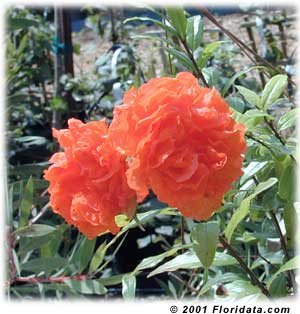
This sudden bonanza of moisture is causing some problems though. In mid-July a week of dry weather inspired the pomegranate tree to burst into bloom. Pomegranates, like figs, hale from the dry climate region around the Mediterranean Sea. The non-dry climate here in Tallahassee is a bit more humid and rainier than the fig would prefer. So when the recent monsoon started, the pomegranate's flowers stopped. Hopefully the weather will stay dry long enough for me to score some flowers (and fruit) later in the year!

Last month I was extremely excited about my impending bumper crop of figs that were just about to ripen. They are so tantalizingly tasty that I was compelled to convey my appreciation for their deliciousness in a poem called The Fabulous Fig . Ironically, I completed my poem just as Tropical Storm Barry breezed through with a deluge...
As it happens, figs ripen best in dry situations (like Mediterranean climates!) This is because the concentrations of sugars and flavor compounds increase as the amount of water in the fruit diminishes resulting in superior lusciousness. It's my observation that figs do not ripen well in wet humid weather. This is because they explode. They absorb so much moisture that they burst open, sag, get moldy and stink. Sugars in the fig ferment transforming it into an alcoholic blob of fetid fruit. Bees, flies, wasps, in fact an entire menagerie of unappealing creatures, arrive to debauch and fornicate upon my festering figs. So the sad fact is that there'll be no fig feast for me this season. But on the positive side, the neighborhood birds are enjoying all-you-can-eat feasts of fig fragments and fat drunken bugs. The wasps might even awaken with hangovers and regrets!
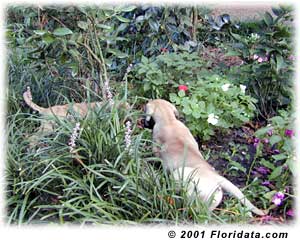
Milestone: Dog Garden Debut
Last spring we remodeled the dog runs. Part of the area had been a chicken yard for years endowing it with the nicest dirt on the place. This project provided an opportunity to expand a nearby shade garden. Camellias, a tea olive, Chinese fountain palms and English ivy had been planted there a decade ago and was at last achieving respectable size. Then last March I spiffed up the area by installing border grass edging to define the beds and then filled them with justicia, Japanese aralia, cast-iron plant and palms. I'm always looking for good places to grow my beloved palms so the shady Dog Garden is now home to a ribbon fan palm (Livistona decipiens) palm (that may or may not survive our winters), the aforementioned Chinese fan palm (L. chinensis), five blue palmettos (Sabal minor) and several hardy bamboo palms (Chamaedorea microspadix).I also planted moonflower vine seeds and I'm having fun watching it compete with the English ivy. The huge, six inch, pure white moonflowers are especially striking against the glossy dark green ivy leaves. I think they should be called them full moonflowers to better convey their brilliant nighttime presence. The Dog Garden has a junglelike ambiance partly due to the presence of many shades and textures of foliage plants and partly due to the fact that I haven't weeded since, uh... for a while... Summertime color in this shady place is courtesy of dependable impatiens, justicia, a dark purple Salvia splendens variety and crepe jasmine.
I have been planning to complete this garden for years so it's great to finally get it going. It's almost time to start thinking about what I want to plant in it this winter... I'll do pansies for sure, and maybe some snapdragons...
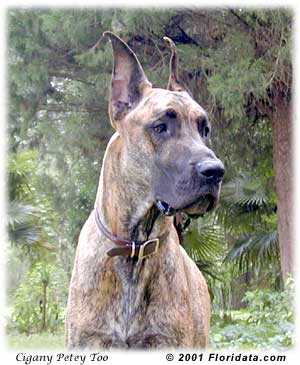
Dog News
As I reported last month, my boy puppy Pete had a lady friend come a-calling. Love was in the air and I'm happy to report that Pete is going to become a daddy in about a month. Congrats to mom and her human. Meanwhile all of Mathilde's puppies have gone to their new homes. Now we're left with one little ten week old girl pup named Susie. Susie is a cutie but has many bad habits yet to overcome like inappropriate pooping, peeing, chewing, barking, etc. This is why nature makes puppies so cute - to make up for all of these other less attractive attributes.
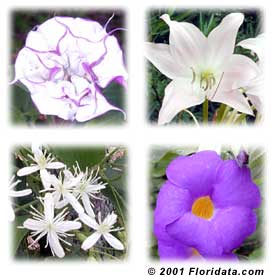
In Bloom at Floridune
The heat and humidity have taken their toll on plants like petunia and ageratum which are looking mighty puny these days. As usual though the impatiens and scarlet sage are going like gangbusters. The tropical species like mandevilla, allamanda and shrimp plant are especially enjoying our rainforest type weather.
My neighbor J.M. gave me several pots of wishbone flower (Torenia fournieri). I'm going to plant my bluewings, as this tender annual is also called, in well drained soil in partial shade. With a little care they'll reseed and I'll have a nice patch of these charming little beauties next year.

I have a couple of really pretty vines growing together on the fence up on the hill. Bright blue Thunbergia vine is backdropped with pure white sweet autumn clematis (see picture). The are so beautiful together that I feel very clever for having accidentally planted them in close proximity. And a nearby purple princess flower, one of my favorite tropical shrubs, imparts a regal ambiance to the scene.
Last fall Steve gave me a bunch of seeds, among them Datura inoxia and D. metel. I planted them in starter pots but the despicable squirrels, as usual, vandalized my effort. I did manage to get one plant though and it has bloomed already. As you can see in the picture, it is pretty enough to justify the effort and squirrel induced aggravation. A warning: if there are children around, don't even consider growing Daturas or Brugmansia species as all parts of these are extremely toxic.
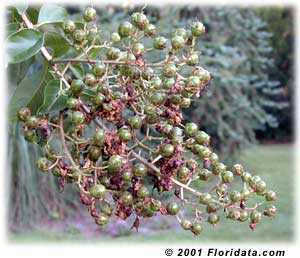
Take Care: Crape Myrtle Encore
Although the late blooming crape myrtle (Lagerstroemia indica) varieties are just beginning to blossom here in Tallahassee, most other varieties' flowers are just a memory - as well as big heavy clusters of greenish seed pods. They look like anorexic grape clusters whose weight droops the crape branches earthward. On the one hand they're rather cool looking and the idea of trimming them off in 92 degree mosquito-saturated heat is particularly heinous. On the other hand if the pod clusters are removed and the tree given a light pruning one is rewarded with more flowers for an end of summer encore of crape color! This year I'm acknowledging both "hands" - I've trimmed six of my shortest crapes but I'm leaving the remainder "natural". The natural crapes look OK and this defers the next round of crape pod cluster cutting until October once the leaves drop, the weather is nicer and the mosquitoes have subsided. Another advantage is that the bare stems reveal the tree's structure making it easier to shape. A crape with a nice form shows off its handsome bark most effectively, especially in winter.
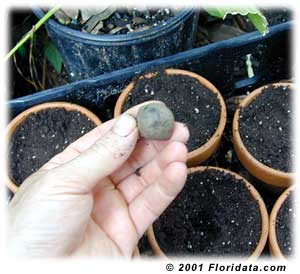
Project: Jubaea Germination
The Chilean wine palm (Jubaea chilensis), also called the coquito palm, is a handsome brute. There aren't many cold hardy feather leaf palms, especially ones of such stature and uniqueness. I first learned of this palm about fifteen years ago and became determined to see if I could grow Jubaea in northern Florida. I searched for years but never found a plant. Last week I discovered coquito seeds for sale on the Internet and I've already planted them. I may have to wait up to six months for them to germinate but I hope they sprout before cool weather sets in because they are very susceptible to fungus in our humid climate. This is a very slow growing palm so I don't know why I'm messing with them - I'd be a hundred years old before they'd ever achieve a fraction of their massive potential! Sometimes I think my time would be better spent growing useful things like lettuce or carrots or something more practical...

Project: Lawn Chair
I didn't get to goof off as much as I had hoped to in July - not at all in fact. And I haven't even gone for a swim in the springs yet and the summer is already winding down. But I have managed a few gardening chores like fertilizing, re-potting and a little pruning (gotta work on my would-be topiaries this month...). It looks like a busy month coming up for me. Whatever time is left after my real job and working on Floridata I'm going to spend out in the garden. I intend to transplant some palm seedlings, plant more palm seeds, fertilize the camellias (I'm late), mulch, and weed - unless I don't feel like it. Either way I hope to spend lots of quality time relaxing with Susie on the lawn chair. See you in September. Stay cool and be good and grow.
John Scheper 08/18/01